Before coming to Prague, one thing that always reminded me of this country was Pavel Nedvěd. A long time ago, I was a fan of Juventus FC, an Italian football team, and my favorite player was Pavel Nedvěd. He was famous for his powerful kicks, earning him the nickname “The Czech Cannon.” Over a decade later, I finally set foot in his home country.
The sky was still dark when the bus arrived at Prague’s bus terminal. During the journey, I couldn’t sleep soundly, even though the bus, RegioJet, offered free tea and hot chocolate to every passenger. The 7-hour-and-15-minute ride from Budapest, Hungary, to Prague, Czech Republic, was spent listening to music on my phone. There wasn’t much to see outside since I started my trip to Prague at 11:15 PM from Budapest.
Feeling exhausted and eager to lie down in bed, I decided to pull my suitcase to the nearest station and head straight to the hostel I had booked. Fortunately, my hostel was right in the city center, so within an hour, I was already sitting comfortably in the lobby, waiting in line to check in. And it turned out to be my lucky day. The receptionist was kind enough to let me check in early so I could get a few hours of sleep before starting my Prague adventure.
HOLIDAY IN PRAGUE, CZECH REPUBLIC: NOT A FORMER SOVIET STATE
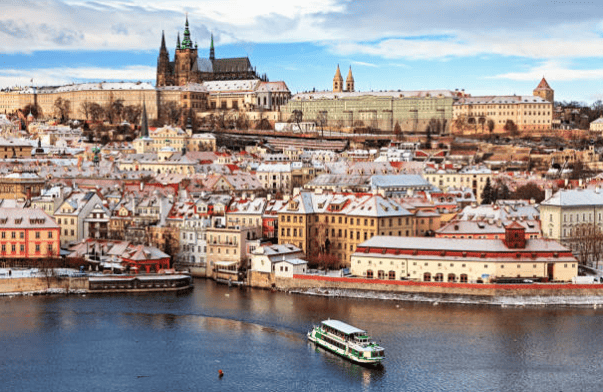
For some reason, I used to associate the Czech Republic with being a former part of the Soviet Union. Do you also think that, or was it just me? In reality, Czechoslovakia was merely a Soviet puppet state. I only learned this while researching Nedvěd’s country before setting foot in what is now a nation separate from Slovakia. The Czech Republic has a long history filled with war and bloodshed, which left me dizzy just reading about it. But that rich and complex history also makes Prague stunning, romantic, and one of the most well-preserved medieval cities in Europe.
To make a long story short, back in the late 9th century, the Czech Republic was known as the Duchy of Bohemia, part of the Moravian Empire. Bohemia later became an imperial state under the Holy Roman Empire in 1002. When the Holy Roman Empire dissolved in 1806, Bohemia became part of the Austrian Empire. Eventually, Czechoslovakia was formed after the Austro-Hungarian Empire collapsed following World War I.
During and after World War II, Czechoslovakia was occupied several times by other countries. First by Germany, which made it a puppet state, and then by the Soviet Union, which invaded Czechoslovakia in 1968. Communism heavily influenced the country after WWII, making it a part of the Eastern Bloc. The oppressive political climate and worsening economic situation sparked the Prague Spring uprising, leading to another Soviet invasion. During this period, Czechoslovakia remained autonomous but was essentially a satellite state of the Soviet Union.
After many years of conflict, peace was achieved in Czechoslovakia through a peaceful revolution known as the Velvet Revolution. The country returned to being a liberal democracy. Then, on January 1, 1993, following the dissolution of Czechoslovakia, the name of the country changed to the Czech Republic or Czechia. In 2004, this Central European nation joined the European Union. Today, Prague, the capital and largest city of the Czech Republic, has become a major tourist destination in Central Europe.
Holiday in Prague, Czech Republic: How to Get There
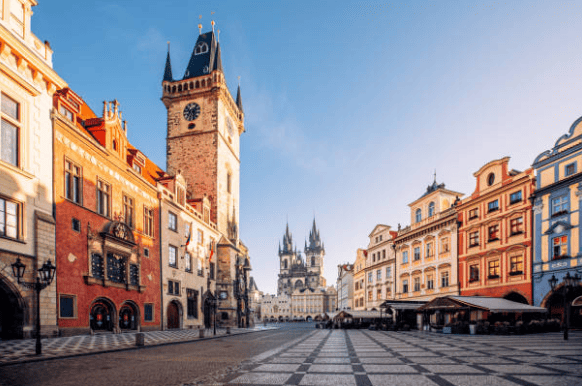
My trip to Central Europe started in Vienna, Austria -> Bratislava, Slovakia -> Budapest, Hungary -> Prague, Czech Republic. From Budapest, I took a RegioJet bus. I deliberately chose the latest bus at 11:15 PM because I wanted to explore Budapest as much as possible before leaving. The bus arrived at Prague’s bus terminal at 6:30 AM. I bought my bus ticket on Omio for €17.5.
Holiday in Prague, Czech Republic: Getting Around
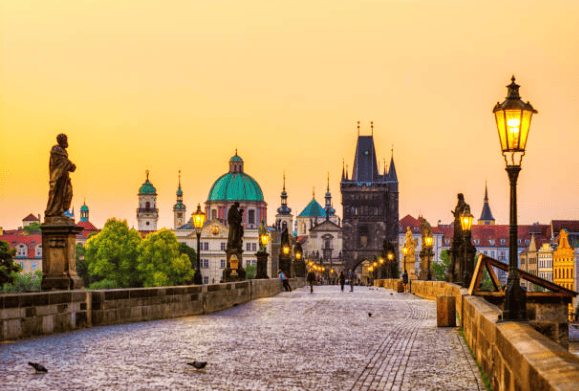
As I’ve mentioned in most of my articles, I prefer to explore cities on foot. While in Prague, I didn’t leave the city center. Walking is the best way to explore central Prague, as many streets are closed to vehicles. Some areas, like the Charles Bridge, are pedestrian-only zones. Make sure to wear comfortable shoes, as there are many cobblestone streets and uphill paths leading to the castle.
Besides walking, you can also use trams, the metro/subway, or buses to reach further areas during your holiday in Prague. The city has an integrated transport system, so one ticket works for all—tram, metro, and bus—and you can switch between them easily.
Single-ride tickets or day passes can be purchased at ticket machines in metro stations, some tram stops, and newspaper kiosks. There are two types of single-ride tickets: valid for 90 minutes or 30 minutes, priced at 32 CZK and 24 CZK, respectively. These allow unlimited transfers within the time limit. If you plan to stay in Prague longer, you can opt for a 1-day pass (110 CZK) or a 3-day pass (310 CZK).
Don’t forget to validate your ticket before boarding the metro, tram, or bus. While ticket checks are rare, getting caught with an unvalidated ticket can result in a fine of 800 CZK on the spot or 1500 CZK if paid at a police station.
Holiday in Prague, Czech Republic: Where to Stay
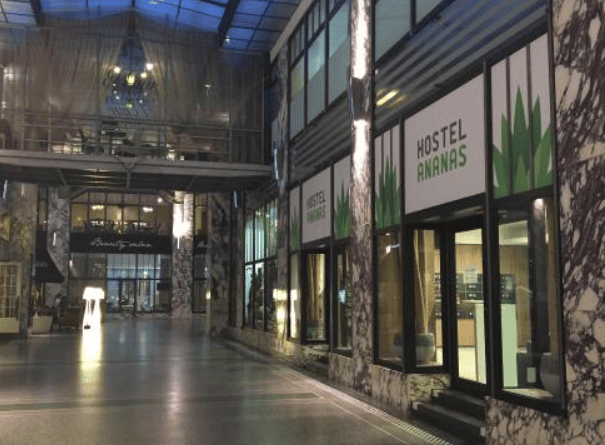
During my holiday in Prague, I stayed at Hostel Ananas, located right in the city center and just 500 meters from the astronomical clock at the Old Town Hall. I booked my stay here, and at the time, the price for a 10-bed mixed dormitory was 219 CZK per night.
I loved this hostel because the staff were so friendly and allowed me to check in early. The location was perfect—right in front of Wenceslas Square, where one of the Christmas markets was held. The rooms were very clean and well-maintained. The hostel also offers several events ideal for solo travelers, such as pub crawls and walking tours. I decided to join the walking tour on my second day in Prague.
Holiday in Prague, Czech Republic: Things to See & Do
1. Old Town
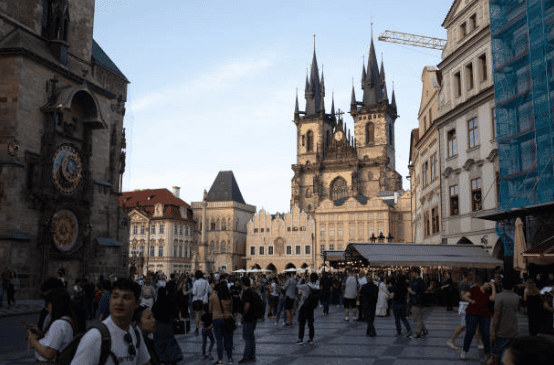
Prague’s Old Town is its main attraction, and it’s so charming that during my holiday in Prague, I found myself daydreaming about living there. Imagine tall, classic-style houses flanking cobblestone streets, with gothic churches at every corner. Prague’s old town feels a bit like Vienna, as Czechia was once part of the Austro-Hungarian Empire. However, while Vienna’s buildings are more in the Vienna Secession style, Prague’s architecture has a darker, gothic feel. That’s part of the city’s magical allure. The old town can feel like a labyrinth, but don’t expect a relaxed stroll—it’s always packed with tourists, much like Venice.
- Hanging out in Old Town Square: In December, the Old Town Square hosts a beautiful Christmas market. If you’re visiting outside the holiday season, you can still people-watch, admire the architecture, or sit on a bench while enjoying trdelník (a traditional pastry) and listening to street musicians.
- Astronomical Clock: One of the oldest astronomical clocks in the world. The clock puts on a fascinating display every hour, with wooden figurines emerging from little doors. When I visited, the clock was under renovation, but it’s now fully restored. Prepare to crane your neck to see it!
- Visiting Churches: You must visit Prague’s churches, as they are stunning! One standout is the Church of Our Lady before Týn, a gothic structure with twin towers that look like they’re wearing black hats. Another is the baroque-style St. Nicholas Church, which is open all day.
- Exploring Prague’s Catacombs: Beneath the Old Town Hall lies a network of underground burial sites worth exploring.
2. Prague Castle

Across the river, atop a hill, you’ll see a group of grand buildings—Prague Castle, built in the 9th century and now the official office of the President of the Czech Republic. It was once home to the Kings of Bohemia, the Holy Roman Emperors, and Czechoslovakia’s presidents.
Before climbing the hill to the castle, you’ll cross the famous Charles Bridge, which connects the old town to the castle. This gothic bridge, lined with artistic baroque statues of saints, was built in 1357 under King Charles IV and completed in the early 15th century.
Prague Castle is like a small city, with multiple buildings to explore, including St. Vitus Cathedral, The Old Royal Palace, St. George’s Basilica, and Golden Lane. The most iconic structure is St. Vitus Cathedral, a towering gothic masterpiece that can be seen from outside the city walls.
The castle is open from 6 AM to 10 PM, with tickets ranging from 70 to 350 CZK.
3. John Lennon Wall
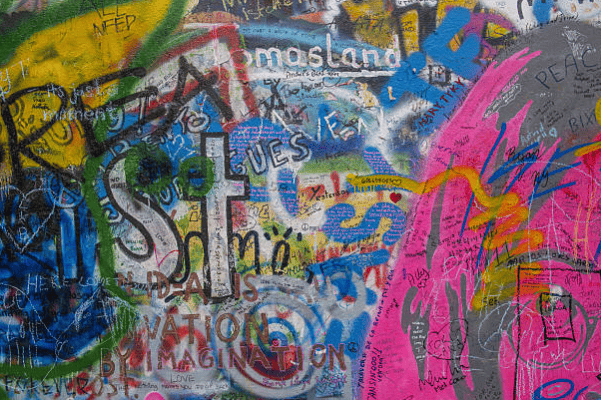
A popular tourist spot due to its name and historical significance, the John Lennon Wall is covered in graffiti, including lyrics from Lennon’s songs. Students began writing on the wall in the 1980s as a form of protest during communist rule. Today, the wall symbolizes peace and love, and visitors are free to add their own messages.
4. Jewish Quarter
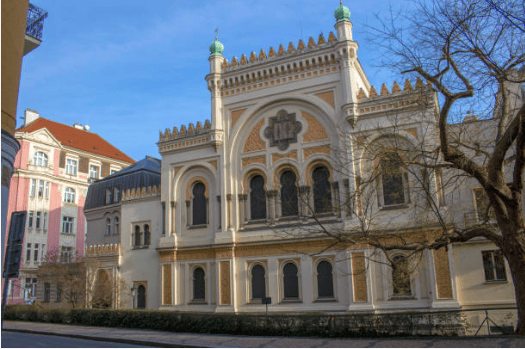
One of the must-visit areas during a holiday in Prague. Once home to one of Europe’s largest Jewish communities, the Jewish Quarter survived WWII because Hitler planned to turn it into a “museum of an extinct race.” Here, you’ll find six synagogues, the Jewish Ceremonial Hall, and the Old Jewish Cemetery.
5. Join a Walking Tour
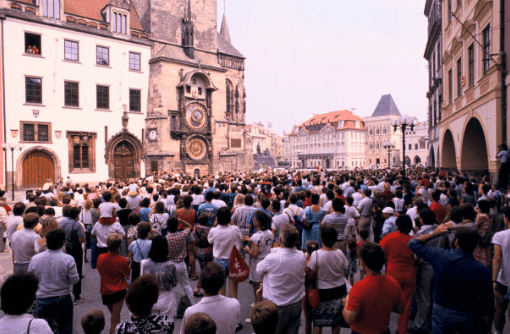
If you’re traveling solo like I was, joining a walking tour is a great way to learn about Prague and its history. Many companies offer walking tours, and I joined one organized by Hostel Ananas. Most tours gather near the Astronomical Clock at 10 AM and last about three hours. The tours are free, but it’s customary to tip the guide if you enjoyed it.
6. Trying Czech Cuisine
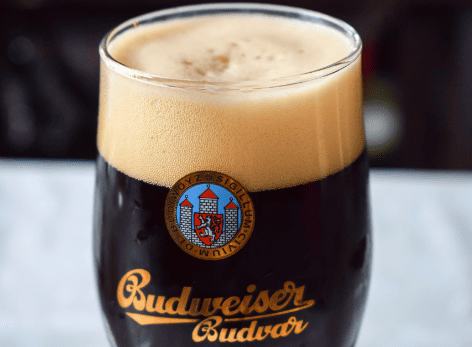
I’d heard a lot about Czech cuisine before my trip, so I was eager to try it. A friend from Slovakia took me to a basement restaurant and bar in Prague to taste goulash and Czech beer. Goulash is a spicy meat stew served with raw onions and horseradish, usually made with beef, though sometimes chicken or pork is used. I found it quite tasty but a bit bland.
Next was Czech beer. Prague is famous for its beer, which is cheaper than water. However, I didn’t find it particularly special. The best beer I’ve had is still in Bruges, Belgium.
My favorite Czech food is trdelník, a traditional rolled pastry coated in sugar, nuts, or cinnamon. It’s usually served warm, and the open-kitchen preparation is a tourist attraction in itself. Though it originates from Transylvania, you’ll find it throughout the Czech Republic.
Rich in history, with a gorgeous old town, a romantic vibe, and plenty of attractions, Prague is a must-see if you’re planning a trip to Europe. There are also nearby destinations like Karlovy Vary and Kutná Hora that are perfect for day trips. Although I didn’t have time to visit them during this trip, I’m saving them for next time. Given the number of attractions in Prague, I recommend allocating at least four days to fully enjoy your holiday in Prague.

аккаунты с балансом купить аккаунт с прокачкой
маркетплейс для реселлеров магазин аккаунтов
маркетплейс для реселлеров безопасная сделка аккаунтов
гарантия при продаже аккаунтов магазин аккаунтов социальных сетей
магазин аккаунтов перепродажа аккаунтов
профиль с подписчиками продать аккаунт
продать аккаунт маркетплейс для реселлеров
маркетплейс аккаунтов купить аккаунт с прокачкой
маркетплейс аккаунтов https://birzha-accauntov.ru
гарантия при продаже аккаунтов маркетплейс аккаунтов соцсетей
продать аккаунт маркетплейс аккаунтов соцсетей
магазин аккаунтов купить аккаунт с прокачкой
маркетплейс для реселлеров аккаунт для рекламы
площадка для продажи аккаунтов маркетплейс аккаунтов соцсетей
аккаунты с балансом аккаунты с балансом
продать аккаунт безопасная сделка аккаунтов
Account Market Account Trading Platform
Secure Account Purchasing Platform Buy and Sell Accounts
Account trading platform Account Acquisition
Sell Account Accounts marketplace
Account Buying Platform Account Selling Platform
Website for Selling Accounts Buy Account
Secure Account Purchasing Platform Account Trading Platform
Sell Account Secure Account Sales
Account Buying Platform Account Trading Platform
Buy Pre-made Account Account Trading
account market secure account purchasing platform
account sale buy pre-made account
account acquisition online account store
account market buy account
sell account sell pre-made account
account exchange service account trading platform
buy pre-made account account selling platform
account selling platform account market
sell pre-made account account exchange
account store ready-made accounts for sale
verified accounts for sale account trading platform
social media account marketplace account trading platform
guaranteed accounts account exchange
guaranteed accounts online account store
account selling platform website for buying accounts
sell account buy pre-made account
sell pre-made account secure account purchasing platform
buy accounts account marketplace
gaming account marketplace account sale
secure account purchasing platform account exchange service
sell account profitable account sales
sell account buy accounts
website for buying accounts account buying service
account market guaranteed accounts
gaming account marketplace account purchase
website for selling accounts account selling service
account trading platform account trading
account trading platform marketplace for ready-made accounts
purchase ready-made accounts accounts marketplace
online account store https://accounts-marketplace.xyz
guaranteed accounts https://buy-best-accounts.org/
guaranteed accounts https://social-accounts-marketplaces.live/
verified accounts for sale https://accounts-marketplace.live
online account store https://social-accounts-marketplace.xyz/
secure account purchasing platform buy-accounts.space
database of accounts for sale https://buy-accounts-shop.pro
database of accounts for sale https://buy-accounts.live
account exchange service https://social-accounts-marketplace.live
online account store accounts-marketplace.online
account exchange account market
биржа аккаунтов akkaunty-na-prodazhu.pro
биржа аккаунтов https://rynok-akkauntov.top/
маркетплейс аккаунтов магазины аккаунтов
биржа аккаунтов https://akkaunt-magazin.online
биржа аккаунтов https://akkaunty-market.live
маркетплейс аккаунтов kupit-akkaunty-market.xyz
биржа аккаунтов https://akkaunty-optom.live
маркетплейс аккаунтов маркетплейсов аккаунтов
площадка для продажи аккаунтов https://akkaunty-dlya-prodazhi.pro
купить аккаунт kupit-akkaunt.online
fb account for sale buy aged facebook ads account
buying facebook account https://buy-ad-accounts.click
buy facebook accounts https://buy-ad-account.top
facebook ad accounts for sale https://buy-ads-account.click
cheap facebook account cheap facebook accounts
buy fb ad account buy ad account facebook
buy aged facebook ads account https://ad-account-for-sale.top/
Эта статья предлагает захватывающий и полезный контент, который привлечет внимание широкого круга читателей. Мы постараемся представить тебе идеи, которые вдохновят вас на изменения в жизни и предоставят практические решения для повседневных вопросов. Читайте и вдохновляйтесь!
Получить больше информации – https://medalkoblog.ru/
fb account for sale https://buy-ad-account.click
buy fb account https://ad-accounts-for-sale.work
buy adwords account https://buy-ads-account.top
google ads account seller https://buy-ads-accounts.click
facebook accounts to buy https://buy-accounts.click/
buy google agency account https://ads-account-for-sale.top
buy google adwords account https://ads-account-buy.work
google ads reseller https://buy-ads-invoice-account.top
google ads agency account buy https://buy-account-ads.work
google ads account for sale https://buy-ads-agency-account.top
google ads account for sale https://sell-ads-account.click
google ads agency account buy https://ads-agency-account-buy.click
buy business manager facebook buy facebook verified business account
google ads account buy google ads account for sale
business manager for sale https://buy-bm-account.org/
buy fb bm https://buy-business-manager-acc.org
buy facebook business account https://buy-verified-business-manager-account.org/
buy verified bm buy-verified-business-manager.org
verified facebook business manager for sale business-manager-for-sale.org
buy verified facebook business manager account https://buy-business-manager-verified.org
buy facebook business manager https://buy-bm.org
buy verified bm facebook unlimited bm facebook
buy verified business manager https://buy-business-manager-accounts.org/
buy tiktok business account https://buy-tiktok-ads-account.org
buy tiktok ads https://tiktok-ads-account-buy.org
buy tiktok ads account https://tiktok-ads-account-for-sale.org
buy tiktok ads account https://tiktok-agency-account-for-sale.org
buy tiktok ad account https://buy-tiktok-ad-account.org
tiktok agency account for sale https://buy-tiktok-ads-accounts.org
buy tiktok ads accounts https://tiktok-ads-agency-account.org
buy tiktok ads account https://buy-tiktok-business-account.org
buy tiktok ads accounts https://buy-tiktok-ads.org
Your point of view caught my eye and was very interesting. Thanks. I have a question for you.
стоматология недорого https://stomatologiya-vladimir-2.ru .
Costs fluctuate primarily based on demand and regional availability, so consumers should
analysis rigorously before purchasing. The most interesting finding from this examine was
that the GTI scores in vasculitis patients remained greater
than in IA as soon as the cumulative dose was saved constant in the regression evaluation. It was hypothesized that sufferers with vasculitis have the next inflammatory response and
are therefore extra susceptible to steroid-toxicity. For occasion, Intravenous Immunoglobulin Substitute Remedy (IVIG) for
MS relapses is given by IV infusion. Individuals with insurance ought to verify coverage, and uninsured individuals should inquire with the ability offering the infusion about financial-assistance packages [5].
A generic drug is an actual copy of the active drug in a brand-name treatment.
The generic is considered to be simply as safe and efficient as the
original drug.
If you would possibly be unsure or if the injection was administered in an space that would probably have an effect on your
capacity to soundly drive, it will be sensible to have another
person drive you. Most of those unwanted effects
can be dealt with with easy solutions like ice packs or over-the-counter pain relievers.
It is my life’s goal and objective to educate the world about the use of efficiency
enhancing drugs. Most unwanted facet effects will go away as soon as the therapy is accomplished, though some like facial mooning and weight achieve can take weeks to completely resolve.
This is particularly true given the high dose you may receive over
a short time period. Treatment is delivered by way of a
versatile tube and needle (called an IV line) right into a vein in your hand
or arm. The drug is normally given in doses between 500 and 1,000 milligrams (mg) per day
for three to 5 days.
You Have received to know no much less than the fundamentals about
which steroids cause which effects, what the drawbacks
are, the most effective cycles and correct dosages.
This is not simply to have the flexibility to gain the best outcomes, however to guard your well being at the identical time.
We see users experiencing roughly 20 kilos of lean muscle (combined with some fats
loss) when taking testosterone for the primary time.
So, we will solely think about what larger doses can do to our
levels of cholesterol. Whereas liver toxicity is a major concern with Winstrol,
an even higher area of concern could be associated to your cardiovascular health.
More specifically, what Winstrol can doubtlessly do to your
levels of cholesterol is to not be ignored. Greater levels of
DHT can stimulate the loss of head hair,
which is so widespread in older males, but when you’re young, Winstrol may cause you to start
out shedding hair a lot earlier in life than you otherwise would have.
Sesame content material is not meant to be a substitute
for skilled medical recommendation, prognosis or treatment.
If you’ve a medical concern, it’s critical to seek the recommendation of your physician or another
certified well being supplier with any questions. If you might be going
through a medical emergency, name 911 or visit the nearest
emergency room immediately. Your supplier will advocate one of the best type of injection for you primarily based on why
you need therapy. Cortisone pictures ship the steroid to
the affected area through a skinny needle.
Cortisone is a man-made model of the cortisol hormone, which the adrenal glands
produce to regulate the immune system. Cortisone controls inflammatory
hormones, which offers pain aid and improves mobility.
Widespread sources embody underground labs, online sellers, and
infrequently diverted pharmacy merchandise,
although quality and safety vary widely. According to the NCBI, the trial is anticipated to make a major contribution to the proof base supporting effective conservative management of CTS in major
care. Previous trials have not immediately in contrast these remedies for
CTS in primary care populations or reported on scientific effectiveness
at greater than 6 months nor compared price effectiveness of the interventions.
The trial outcomes are anticipated to make an necessary contribution to the proof base available to support efficient conservative
administration of CTS in primary care. Further discussions among material
specialists revealed that ESIs provided a minimum of
50% pain aid in patients with this situation.
If the product does not meet the expectation, they refund or enable return. Be cautious of vendors
who don’t possess clear return insurance policies or
have none in any respect. This is especially
essential when shopping for from an internet store or underground lab.
The lab tests should point out the steroid’s purity,
dosage and guarantee it’s unfaked. Even although the
price might be costlier, you would obtain a product that’s guaranteed to be
real and has been completely tested. No Matter the case may be, whether you are an skilled person or somebody new to this treatment, knowing the pricing choices and where to buy Anavar on-line is necessary.
Testosterone Cypionate usually sells for $50 to $150 per vial on the road,
relying on elements like model, location, and provider reliability.
This is why most people use Winstrol sparingly and at times when it goes
to be of most benefit – similar to before competitions.
If you’re not a fan of injecting, then that alone may
be sufficient to have you ever taking a look at Winstrol oral as
a substitute, regardless of a few of these benefits of Winstrol Depot.
When prescribed in certain doses, corticosteroids help scale back inflammation. This
can ease signs of inflammatory situations, similar
to arthritis, asthma and pores and skin rashes.
This is when the dosage of the energetic ingredient in the steroid is considerably less than what’s advertised,
causing the product to be less effective. Injectable steroids with short esters like Propionate, Phenylpropionate
and Acetate would require 8-10 weeks to provide the
whole listing of desired effects. Masteron is a steroid to scale back excess
oestrogen levels in breast most cancers patients, which
is also beneficial for male steroid users who experience aromatization.
It simply means you want to remember of the best types of
steroids for muscle building (https://golfindustria.es/pages/comprar_testosterona.html) of steroids to use
for what you’re trying to realize. And, for us bodybuilders, it’s the anabolic steroid category
that serves our needs. Frontloading Testosterone Enanthate can get
your blood plasma ranges as much as 500mg much quicker. This entails taking a double dose
of 1000mg on the primary day (or whatever might be double the amount of your chosen regular
dosage).
Those small weight increments are what eventually add as much as big increases
in strength and extra muscle mass. Equally, you probably can take a set weight and add a rep every time.
Over the years, steroids have taken on a distinguished position in a
bodybuilder’s method to building a championship-caliber physique.
It’s a blueprint for constructing sensible, individualized steroid cycles — designed that will help
you develop muscle, reduce fat, or do each with out compromising your long-term health.
The most effective approach to increase pure testosterone manufacturing is
taking in pure ingredients that enhance your testosterone manufacturing.
Having excessive pure testosterone manufacturing is clearly not as efficient as taking in steroids.
The truth is, bodybuilding naturally and with steroids is a really
different experience.
Research have proven that 6mg and 10mg doses are profitable
for increasing testosterone levels, whereas small
doses of two.5mg are unsuccessful (5). Testogen incorporates
20mg of boron, thus making for a really efficient dose.
In this text, I will advocate the dietary supplements that have given me positive
aspects whereas exposing the ones that haven’t.
It additionally spikes free testosterone, with it binding less to SHBG (sex hormone-binding globulin).
SHBG is a protein within the blood and is liable for lowering the bioavailability of testosterone (4).
One examine noticed Boron nearly triple testosterone levels (2), rising from 0.31 ng/mL to
0.eighty three ng/mL. In another study, common boron supplementation significantly elevated
free testosterone levels (3). For instance, if a person takes a powerful fat burner to lose weight but carries
on overeating or skips cardio sessions, they is most likely not happy with the end end result.
Rigorous preparation, stage time, and genetics are what
make these competitions so thorough. We have had sufferers who took
legal steroids for women and did not train, and they built muscle
and burned fats regardless of being sedentary. Nonetheless, their
results are notably less in comparability with
users who combine steroids with weightlifting.
Primobolan can add as a lot as 10 pounds of muscle while
inducing subcutaneous fats loss. Related to Anavar, Primobolan is extra common among ladies, with fewer incidents of virilization in our experience.
Important hepatotoxicity from Winstrol necessitates relatively temporary cycles to prevent excessive liver harm.
Equally, we now have discovered that a small calorie deficit is perfect for max fat loss and muscle retention, which enhances slicing steroid cycles.
Pure bodybuilding is a self-discipline that promotes
clean competitors and sets excessive standards for athletes.
These bodybuilders depend on their genetics, hard work, and a clean food regimen to realize their desired physique.
By avoiding the usage of performance-enhancing medication and steroids, pure bodybuilders prioritize their
well being and well-being. Dietary Supplements might help fill any gaps in your
food regimen and provide additional vitamins for muscle constructing.
They are additionally wealthy in fiber, comprise helpful amino acids corresponding to arginine, and are good sources of a number of
nutritional vitamins and minerals (79). Nuts that have been proven to have anabolic effects include macadamia nuts, brazil nuts, and tiger nuts.
Some forms of nuts have been discovered to lift SHBG levels,
making testosterone inactive and lowering androgen bioavailability.
The number of one of these two determines the aim of taking steroids.
Hold carbs within the last two meals of the day to
help you unwind. And eating carbs midday could
take off the mental edge when you want it. If you’ve carbs earlier than and in the course of the workout, you don’t want extra carbs
after the session. Have as a lot as 50% of your every day carb intake
before or during. The rest of the non-protein caloric intake would come from
fats. If you ingest carbs, you keep blood sugar levels
greater, so there’s much less need to provide cortisol.
Some believe it really works very well for increasing testosterone and have skilled obvious
muscle positive aspects (including myself). Other individuals, nonetheless, discover nothing, reporting zero gains or side effects.
Testosterone is the male hormone that’s responsible for muscular strength
and measurement. The extra free testosterone a male naturally produces, the extra muscle mass he will have.
Under is my list of the highest natural bodybuilding dietary
supplements (as a result of me taking virtually every supplement beneath the sun).
Pure bodybuilders work onerous through exercise, food plan, and rest.
Nonetheless, it’s also true that if you are keen to put within the exhausting work and
dedication, you’ll be able to construct a powerful physique with out using steroids.
On one side of the argument of natty vs juice, some folks imagine that solely through the
usage of steroids can one obtain a very spectacular physique.
To regulate testosterone, estrogen levels are raised, and this causes delicate breasts
to emerge. Bear in mind, it’s not each man that develops this condition when on steroids, but it is a danger.
As I talked about a moment ago, a number of the legal steroids
that I’ve fallen in love with over the
previous couple of years work even better when they’re mixed with different choices.
You have to be sensible, you have to be strategic, and you have to be actually cautious about
which of the legal steroids you choose to go together with shifting ahead.
Of course, then you’ve a complete bunch of merchandise which are efficiency enhancement options.
Truth be informed, “legal steroids” aren’t precisely steroids
in the conventional sense. My energy ranges skyrocketed,
my endurance levels skyrocketed, and my wife undoubtedly
noticed a couple of massive “performance enhancements” from utilizing this Improve
supplement, too. Solely out there by way of Huge
Vitamin, it’s necessary to essentially comply with the
dosing to actions on this unhealthy boy to the letter.
You’re going to need to go through a full 8 to 12 weeks cycle to get the best results out of this legal steroid,
too.
Cortisol, launched in response to emphasize, was essential
for survival in our evolutionary past. We know
you want dependable injectable testosterone and effective oral steroids, and we have received you lined.
Our shop is your go-to supply for purchasing the most effective steroid products on-line that deliver real outcomes.
Our costs are unbelievable, and we regularly have great sales
that make it even simpler to replenish on what
you need.
For example, testosterone can enlarge a woman’s clitoris and decrease her breast size.
Our LFTs (liver operate tests) present that ALT and AST liver values do not rise from legal steroids,
making certain a wholesome and guarded liver. As A Outcome Of Winstrol does not have a very important impact on constructing mass (7),
we see it typically utilized in cutting cycles to help retain muscle whereas
getting leaner. Winstrol has diuretic results too, rising muscle striations
and the visibility of veins (vascularity).
With the suitable information and instruments, you’ll have the ability to confidently begin your path
to reaching your health aims. Some suppliers might not have products on hand, however order from a bigger
supplier after receiving your fee. Be suspicious if the delivery time does not match as much as the placement
they claim to ship from.
This recovery time helps forestall overtraining and promotes adaptation.
Deloading allows your body to recover from amassed fatigue attributable to intense coaching.
Larger hormone ranges correlate with higher restoration and a higher MRV.
Decide for third-party tested and licensed supplements to ensure potency and purity.
Home Provide offers a few of the handiest steroids for muscle achieve,
together with Dianabol, Trenbolone, and Deca-Durabolin. We
recommend consulting with healthcare professionals to know the best options on your
wants. The firm is understood for producing high pharmaceutical-grade,
and rigorously tested performance-enhancing merchandise in addition to PCT therapies.
You can obtain a extensive array from Magnum Pharmaceuticals, together with a
big selection of oral and injectable steroids for sale,
with oils which might be mentioned to be a variety of the smoothest obtainable.
Finding a dependable supplier is crucial whether you have opted to buy anabolic steroids on-line in the
Usa or from a store with US transport from abroad.
Here’s what you have How To Obtain Steroids remember while purchasing for a reliable provider.
The essential details concerning the secure
use of anabolic steroids has become more accessible nowadays, significantly with
the web.
Accountable purchasing practices and thorough analysis are key to
safeguarding your health and maximizing the advantages of Anavar
usage. All The Time prioritize accountable use, educate yourself about
potential risks and precautions, and search skilled
steerage to ensure a safe and effective Anavar cycle.
By following a structured cycle, users purpose to maximise
the advantages of Anavar whereas minimizing potential risks and side effects.
Understanding the key parts and concerns
of an Anavar cycle is crucial for reaching desired results and sustaining general health and well-being.
Pharmahub is a distribution network for various pharmaceutical suppliers.
Their stock is unparalleled they usually offer specific
offers that can’t be found on the person web sites. At the end of the day, pharmahub did their job and
brokered the supplies.
You not need to fret about the method to get anabolic steroids in America because we have you covered.
Our web site operates 24 hours a day, seven days a week, so you could buy
steroids within the US everytime you like. Just go to our
web site and choose from our massive choice of oral and injectable steroids for sale
within the USA. Nearly one-third of folks that misuse anabolic
steroids turn into dependent on them. That means over time
it begins to take higher and extra frequent doses to get the
identical results.
70918248
References:
advanced Steroid cycles
шкаф для колес в паркинг шкаф для колес в паркинг .
производство кухонь по индивидуальным размерам https://kuhnni-na-zakaz1.ru .
70918248
References:
best Steroid stack
70918248
References:
using steroids before and after (https://govtcollegekeolari.org/navigating-the-world-of-digital-marketing-courses/)
70918248
References:
what is a steroid; Marian,
70918248
References:
best website to buy steroids, http://Www.toycarland.com,
купить септик для частного дома купить септик для частного дома .
70918248
References:
none, http://www.restgarage.jp,
¡Saludos, descubridores de oportunidades !
Mejores casinos online extranjeros con tragaperras en vivo – п»їhttps://casinosextranjerosenespana.es/ mejores casinos online extranjeros
¡Que vivas increíbles jugadas excepcionales !
¡Hola, aficionados a las apuestas!
Casinossinlicenciaespana.es – Toda la acciГіn – https://casinossinlicenciaespana.es/ casinos sin licencia espaГ±ola
¡Que experimentes botes sorprendentes!
¡Hola, jugadores apasionados !
casinoonlinefueradeespanol con herramientas de control – https://www.casinoonlinefueradeespanol.xyz/# casinos online fuera de espaГ±a
¡Que disfrutes de asombrosas tiradas afortunadas !
¡Saludos, descubridores de tesoros !
Mejores tragaperras en casinos online extranjeros – п»їhttps://casinosextranjero.es/ mejores casinos online extranjeros
¡Que vivas increíbles instantes inolvidables !
кредит с испорченной кредитной историей кредит с испорченной кредитной историей .
¡Saludos, jugadores dedicados !
CГіmo identificar un buen casino online extranjero – п»їhttps://casinoextranjerosenespana.es/ casinos extranjeros
¡Que disfrutes de instantes irrepetibles !
¡Bienvenidos, amantes del entretenimiento !
Casino fuera de EspaГ±a sin control de identidad – https://casinoporfuera.guru/# casinos fuera de espaГ±a
¡Que disfrutes de maravillosas momentos memorables !
¡Hola, entusiastas de la emoción !
Casino online extranjero con tragamonedas progresivas – п»їhttps://casinoextranjero.es/ mejores casinos online extranjeros
¡Que vivas victorias legendarias !
кредит на карту с просрочками без отказа http://www.kredit-bez-otkaza-1.ru .
срочный займ онлайн без отказа мгновенно http://www.zajm-bez-otkaza-1.ru .
¡Saludos, descubridores de tesoros!
casino por fuera sin impuestos locales – https://www.casinosonlinefueraespanol.xyz/# casinos online fuera de espaГ±a
¡Que disfrutes de premios espectaculares !
¡Hola, descubridores de oportunidades !
Casino online extranjero con ruleta automГЎtica – п»їhttps://casinosextranjerosdeespana.es/ п»їcasinos online extranjeros
¡Que vivas increíbles jugadas espectaculares !
¡Bienvenidos, fanáticos del juego !
Casino online fuera de EspaГ±a disponible globalmente – https://casinofueraespanol.xyz/# casinofueraespanol
¡Que vivas increíbles recompensas fascinantes !
¡Saludos, apostadores habilidosos !
Casino online extranjero: juega sin lГmites desde casa – https://casinoextranjerosdeespana.es/# mejores casinos online extranjeros
¡Que experimentes maravillosas botes extraordinarios!
?Hola, fanaticos del entretenimiento !
casino fuera de EspaГ±a con opciГіn de juego demo – п»їhttps://casinosonlinefueradeespanol.xyz/ casinos fuera de espaГ±a
?Que disfrutes de asombrosas triunfos epicos !
Hello protectors of healthy air !
Air Purifiers for Smokers – Get Better Air Quality – http://bestairpurifierforcigarettesmoke.guru air purifier for smoke smell
May you experience remarkable unmatched comfort !
¡Hola, jugadores expertos !
Casino sin licencia con soporte vГa WhatsApp – http://casinosinlicenciaespana.xyz/ casino online sin licencia espaГ±a
¡Que vivas increíbles jugadas brillantes !
маленький угловой кухонный гарнитур купить маленький угловой кухонный гарнитур купить .
центр психологической помощи центр психологической помощи .
¡Bienvenidos, buscadores de fortuna secreta !
Casinos sin licencia EspaГ±a sin espera – http://mejores-casinosespana.es/ casino sin licencia espaГ±a
¡Que experimentes maravillosas premios excepcionales !
¡Saludos, buscadores de fortuna escondida !
Casino sin licencia sin verificaciГіn facial – https://audio-factory.es/# mejores casinos sin licencia en espaГ±a
¡Que disfrutes de asombrosas triunfos inolvidables !
¡Hola, descubridores de fortunas !
Casino online sin licencia y sin lГmites diarios – https://www.casinosonlinesinlicencia.es/ mejores casinos sin licencia en espaГ±a
¡Que vivas increíbles jugadas destacadas !
¡Saludos, entusiastas del éxito !
Bono casino EspaГ±a top verificados – https://bono.sindepositoespana.guru/ casinos con bonos de bienvenida
¡Que disfrutes de asombrosas botes sorprendentes!
самая большая муравьиная ферма купить kupit-muravinuyu-fermu-1.ru .
Greetings, strategists of laughter !
One liner jokes for adults with quick wit – http://jokesforadults.guru/# hilarious jokes for adults clean dirty
May you enjoy incredible surprising gags!
аренда экскаватора москва и область аренда экскаватора москва и область .
Hello supporters of wholesome lifestyles !
Invest in the best smoke air purifier for cleaner air after cooking or smoking. These models excel in removing fine particles and strong smells. A best smoke air purifier option is also energy-efficient.
To remove lingering particles, use an air purifier to remove smoke after guests leave. It helps restore freshness in curtains, carpets, and upholstery. best air purifier for cigarette smoke Quick deployment delivers noticeable results.
Portable air purifier for cigarette smoke – п»їhttps://www.youtube.com/watch?v=fJrxQEd44JM
May you delight in extraordinary remarkable freshness !
servicios del centro de cosmetolog?a servicios del centro de cosmetolog?a .
врачи косметологи цена врачи косметологи цена .
Check this out https://rhino-de.com/
I love what you guys are up too. This type of clever work and coverage! Keep up the excellent works guys I’ve incorporated you guys to my own blogroll.
Hi there! Someone in my Myspace group shared this website with us so I came to look it over. I’m definitely enjoying the information. I’m book-marking and will be tweeting this to my followers! Great blog and wonderful design and style.
Hey just wanted to give you a quick heads up. The words in your article seem to be running off the screen in Safari. I’m not sure if this is a format issue or something to do with web browser compatibility but I figured I’d post to let you know. The layout look great though! Hope you get the problem fixed soon. Kudos
¿Saludos exploradores de la suerte
Los mejores casinos europeos permiten invitar amigos con enlaces personalizados que otorgan recompensas a ambos. Es una forma de crecer la comunidad. casinos europeos Jugar en grupo tambiГ©n tiene ventajas.
Casino Europa ofrece integraciГіn con relojes inteligentes para notificaciones y control de sesiГіn. Esta innovaciГіn tecnolГіgica estГЎ disponible solo en algunos casinos europeos online. Es ideal para quienes valoran la conectividad.
Mejores bonos de bienvenida en casino Europa – п»їhttps://casinosonlineeuropeos.guru/
¡Que disfrutes de grandes jackpots!
строительство домов строительство домов .
Looking for a great way to start your online gaming experience? Register as a new user at betx24 and instantly claim your $100 bonus! It’s a fast and simple process, and once you log in, you can begin using your bonus on your favorite games. Don’t miss this opportunity to boost your chances of winning right from the start!
отделка квартиры в новостройке цены отделка квартиры в новостройке цены .
Pinco onlayn kazino mobil üçün ideal platformadır.
Pinco kazinosunun mobil versiyası istənilən cihazda işləyir.
Pinco casino azerbaycan onlayn oyunlarda yeni səviyyə yaradır.
Pinco casino azərbaycan təhlükəsizlik baxımından tam uyğundur.
Pinco casino ilə qazandıqca oynamaq istəyəcəksən.
Pinco oyunları hər zaman yenilənir və maraqlı qalır.
Pinco casino tətbiqi sürətli yüklənir və dərhal işləyir.
Pinco onlayn kazinoda seçimlər sonsuzdur.
Pinco promo code ilə daha çox bonus qazan pinco casino apk download.
Cách Xác Minh Danh Tính Để Rút Tiền Tại https://vin88-vi.com Nhanh Nhất
Very well written, thanks!
Explore the topic of are there casinos in florida and get insider
insights that truly matter. We’re committed to fairness, accuracy, and player-focused content.
All our featured casinos follow strict compliance standards and come loaded with generous sign-up offers
and rewards. Learn how to enjoy gambling safely while taking advantage of bonuses, high-return games, and
trusted services designed for both beginners and professionals alike.
I have been browsing on-line more than 3 hours as of late, yet I by no means found any interesting article like yours. It is pretty value sufficient for me. In my view, if all site owners and bloggers made good content material as you probably did, the internet will likely be a lot more helpful than ever before.
Curious about where can i watch casino?
Discover everything you need to know with our expert-approved guides.
We focus on fair gameplay, responsible gambling, and secure platforms you
can trust. Our recommendations include casinos with top-rated bonuses, excellent support, and real
player reviews to help you get the most out of every experience.
Whether you’re new or experienced, we make sure
you play smarter with real chances to win and safe environments.
Searching for reliable answers to is there a house hedge on schedule 1 casino?
We provide detailed, trustworthy information backed by real casino experts.
Our goal is to help you enjoy secure gambling with top-tier platforms that value integrity.
Expect transparent gameplay, verified promotions, and 24/7 support
when you follow our recommendations. Join thousands of players choosing
fair, exciting, and bonus-rich environments for their online casino journey.
Searching for reliable answers to how many casinos did trump bankrupt?
We provide detailed, trustworthy information backed by real casino experts.
Our goal is to help you enjoy secure gambling with top-tier platforms
that value integrity. Expect transparent gameplay, verified promotions, and 24/7 support
when you follow our recommendations. Join thousands of players choosing fair, exciting, and bonus-rich environments
for their online casino journey.
Searching for reliable answers to how much do casino dealers make?
We provide detailed, trustworthy information backed by real casino experts.
Our goal is to help you enjoy secure gambling with top-tier platforms that value integrity.
Expect transparent gameplay, verified promotions, and 24/7 support when you
follow our recommendations. Join thousands of players choosing fair, exciting, and
bonus-rich environments for their online casino journey.
Explore the topic of what is the best online casino and get insider insights that truly matter.
We’re committed to fairness, accuracy, and player-focused content.
All our featured casinos follow strict compliance standards and
come loaded with generous sign-up offers and rewards.
Learn how to enjoy gambling safely while taking advantage
of bonuses, high-return games, and trusted services designed for both beginners and professionals alike.
Curious about don laughlin casino?
Discover everything you need to know with our
expert-approved guides. We focus on fair gameplay, responsible
gambling, and secure platforms you can trust. Our recommendations include casinos with top-rated bonuses, excellent
support, and real player reviews to help you get the most out of every experience.
Whether you’re new or experienced, we make sure you play
smarter with real chances to win and safe environments.
Curious about how much does a casino dealer make?
Discover everything you need to know with our expert-approved guides.
We focus on fair gameplay, responsible gambling, and secure platforms you can trust.
Our recommendations include casinos with top-rated bonuses, excellent
support, and real player reviews to help you get the most out
of every experience. Whether you’re new or experienced, we make sure you play smarter with real chances to win and safe environments.
Curious about how many casinos are in las vegas?
Discover everything you need to know with our expert-approved guides.
We focus on fair gameplay, responsible gambling, and secure platforms you can trust.
Our recommendations include casinos with top-rated bonuses, excellent
support, and real player reviews to help you get the most out
of every experience. Whether you’re new or experienced, we make
sure you play smarter with real chances to win and safe environments.
Explore the topic of how to play craps at casino and get insider insights that truly matter.
We’re committed to fairness, accuracy, and player-focused content.
All our featured casinos follow strict compliance standards and come loaded with generous sign-up offers and
rewards. Learn how to enjoy gambling safely while taking advantage of bonuses,
high-return games, and trusted services designed for both beginners and professionals alike.
Curious about how old to go to casino?
Discover everything you need to know with our expert-approved guides.
We focus on fair gameplay, responsible gambling, and secure platforms you can trust.
Our recommendations include casinos with top-rated bonuses, excellent support,
and real player reviews to help you get the most out of every experience.
Whether you’re new or experienced, we make sure
you play smarter with real chances to win and safe environments.
Go on, click here https://paulinemonsallier.fr/pk/?jackpot-casino
https://mfarhat.promeo-capnumerique.fr/vn/?8đay
https://www.600.pw/vn/?dd7-cleaner